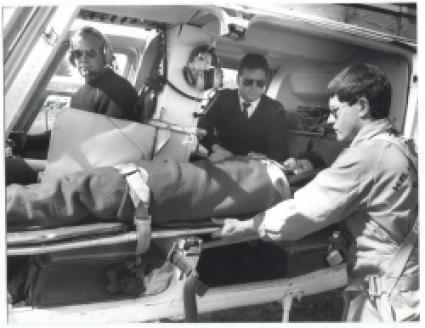History
The Hawke's Bay Rescue Helicopter was established in 1984 to provide a dedicated rescue helicopter service to Hawke's Bay. Read on to find out how our life saving service started.
In the 1960’s, local helicopters that were used for agricultural work (primarily spraying of crops) in Hawke’s Bay would be called in to help when helicopter retrieval and transport was required for patients.
Spraying gear would be taken out of the helicopter and replaced with a stretcher for the patient. Very often, the stretcher was mounted onto the helicopter skids, and once airborne, communication with the patient was almost impossible due to the noise of the helicopter and the wind.
The helicopter would normally take the patient to a waiting ambulance before being transported to hospital by road.
In 1971, the first Rescue Helicopter service in New Zealand was launched on Auckland’s west coast. In Hawke’s Bay, the local agricultural helicopters would attend around 20-30 rescues each year.
In 1984, the Hawke’s Bay Helicopter Rescue Trust was established by a group of community-minded individuals, set up by Chief Inspector Paul Wiseman. This group included representatives from the Porangahau Diving Club, Waimarama Surf Club, Police, Civil Defense, as well as existing members Noel Houston, Garrie Griffiths, and Trauma Doctors Forbes Bennett and Greg Beecham
The group identified the need for a dedicated retrieval and transportation system for critically ill patients in the Hawke's Bay Region, with Dr Bennet and Dr Ward from Hasting Hospital particularly committed to the 'golden hour' theory of getting severely injured people to a medical facility within 60 minutes for the best chance of survival.
The Rescue Helicopter service was initially established primarily for water rescues but in 1989 expanded to involve patient transfers, police searches, accident recovery and marine emergencies.
In 1985 a CAA approved helicopter pad was completed at the Hastings Hospital (now named the Hawke’s Bay Fallen Soldiers' Memorial Hospital).
A Bell Jet Ranger helicopter, owned by Wanganui Aero Works, was used for the rescues and in 1989 the machine was sold to Mike Groome of Te Onepu Helicopters and continued doing part time rescue work.
In 1991, the Trust came to a ‘cross roads’ when Te Onepu Helicopters sold the Bell Jet Ranger, and the Trust had to decide whether to discontinue it's service, or set up a new dedicated service.
Luckily, key people within the community, and representatives at the Trust and the hospital recognised the value of the service to the region, and worked together to set up the service that still operates today.
Andy Train, who was then the Commissioner of the Hawkes Bay District Health Board, approached Hastings businessman Mike Toogood, to see if he would be interested in undertaking the necessary investment and work to establish a dedicated rescue service.
Within five months, the service became a reality when Mike purchased a Eurocopter AS350BA “Squirrel” helicopter and secured sponsorship support from Lowe Walker NZ Ltd.
As a condition of the Lowe Walker sponsorship, Mike became the first CEO of the Trust and held responsibility for the operation of the rescue helicopter service - responsibilities that continue today.
In 1992, the first helicopter hangar was built at the Hawke’s Bay Regional Hospital and in 2001 a larger facility was established in the hospital grounds. The hangers were built with generous support from Hawke’s Bay businesses and the community.
In 1997, Lowe Walker changed their company name to Lowe Corporation. The service has since been known as the Lowe Corporation Rescue Helicopter Service and the Lowe Corporation continue to be the Trust’s Principal Sponsor.
The Hawke's Bay Rescue Helicopter Trust continues to save lives and expand its capabilities, thanks to the generous support and contributions made by individuals, groups, businesses and sponsors within the Hawke’s Bay community.
In 2009, the Trust moved from a single engine Squirrel to a twin engine BK117 rescue helicopter option. The main reasons for the change were to comply with Civil Aviation (CAA) rules on flying over built up areas, greater access to patients in flight, and the ability to carry additional personnel on missions; greater weight and performance. The BK117 has enabled the Trust to future proof an essential service for the Hawke’s Bay region.
In late 2018, we moved to a modern BK-117D2. This was in response to ACC and Ministry of Health's plan for a modernization of the Rescue Helicopter Service nationwide. This modern helicopter was extensively refurbished with all of the very latest safety equipment and navigational equipment.

An early example of helicopter rescue in the 1970s













